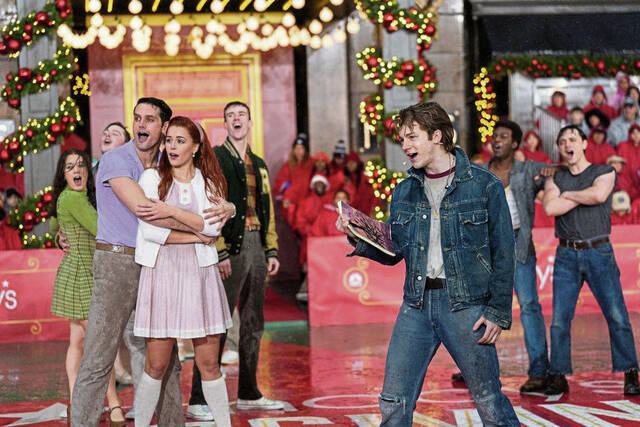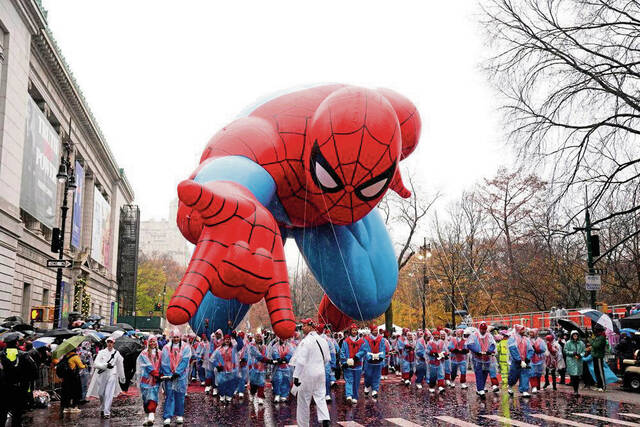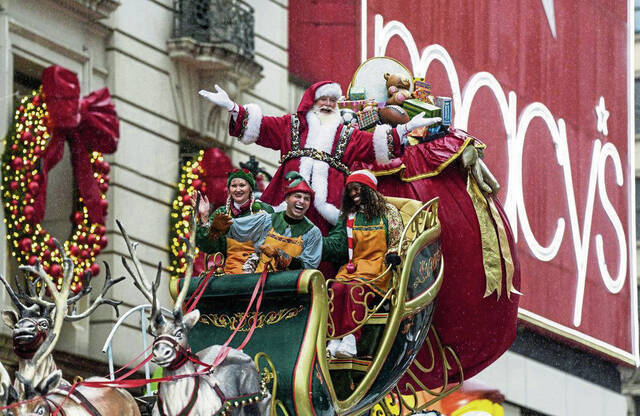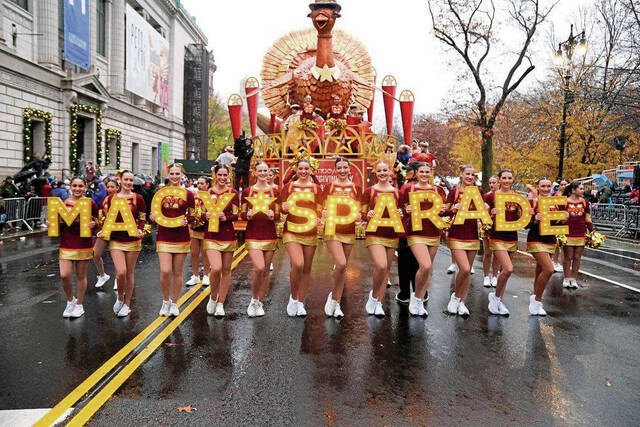TV Talk: How Macy’s Thanksgiving Day Parade evolved through the decades (and how it stayed the same)
“Macy’s Thanksgiving Day Parade” (8:30 a.m. Thursday, WPXI) has always been an inherent promotional opportunity for its namesake department store, an effort to jump-start the holiday shopping season.
But as TV evolved over the decades, so has NBC’s parade telecast.
A static camera trained on a parade may have been sufficient in the 1960s when there were three commercial TV networks, but the rise of cable TV in the ’80s and ’90s and the advent of streaming in the 2010s quickened the pace of all TV programming.
Like NBC’s coverage of the Olympics, which sometimes has a hard time sticking to showing sporting events and often defaults to packaged human interest pieces, the “Macy’s Thanksgiving Day Parade” telecast nowadays often forgoes simple parade shots for performances, often from Broadway shows.
“The Macy’s Parade looks an awful lot like it has looked for decades and decades and decades, but there are more sponsored kinds of things. It is more over-produced,” said Robert Thompson, founding director of the Bleier Center for Television and Popular Culture at Syracuse University’s Newhouse School of Public Communications.
Jen Neal, executive vice president for NBCUniversal live events and specials, acknowledged that the scale of the parade has grown over its history and the telecast has evolved with technology.
“We’ve been able to add camera angles that give viewers unprecedented access points,” Neal said via email. “We’ve been able to incorporate social media in ways that enhance the broadcast. And we’ve added marquee performances at the starting line and in Herald Square from music’s biggest stars that create show-stopping moments for television.”
In the late author Robert M. Grippo’s 2009 book “Macy’s: The Store. The Star. The Story” ($30, Square One Publishers), Grippo recounts the parade’s origins in 1924, showing what hasn’t changed. From that first effort, when it was called Macy’s Christmas Parade, the parade has always concluded with the arrival of Santa Claus.
The first parade telecast occurred on a local New York TV station in 1939, with the first national network telecast in the late 1940s. NBC became the official parade broadcaster in 1953. The telecast began as a one-hour program; it grew to two hours in the 1960s, three hours in the ’70s and added another half-hour (moving from a start time of 9 to 8:30 a.m.) in 2023.
“We’ve got three major holidays in this country that are centered almost primarily around a television show: New Year’s Eve, Super Bowl Sunday and Thanksgiving,” Thompson said. “The Macy’s Parade established itself as one of the central properties of the holiday in that post-war period. (Before then) Thanksgiving was essentially family getting together and eating a turkey. There wasn’t a whole lot of other stuff there. When television emerges and by the time we get to the ’50s, TV drives right into the middle of our domestic space and parks there.
“(Thanksgiving) was an obvious, open parking space,” Thompson continued. “Family is arriving. Everybody’s in the house. Food is being prepared. You need something to lubricate the tension of all of that stuff that’s happening. And that parade was the perfect thing to have on in the background. I never had the image of anybody sitting down watching it. It was just always on, kind of like ‘New Year’s Rockin’ Eve.’ ”
Grippo’s book chronicles the presence of balloons in the parade beginning in 1927 — the balloons were substitutes for live animals, which scared some children — but it wasn’t until 1977 that brand-name characters began to replace generic balloons (pilgrim, fish) with the advent of Kermit the Frog, followed by additional characters like Yogi Bear, Spider-Man, Big Bird, Snoopy, etc.
In addition to promoting Macy’s itself, the parade has long been a promotional platform for NBC.
The 1984 parade featured Soleil Moon Frye, star of NBC’s “Punky Brewster,” singing “Swinging on a Star,” and cast from NBC’s sci-fi show “V” riding in a futuristic car.
As NBC changed hands, the company assets promoted in the parade morphed. NBC and Universal Pictures came under the same corporate umbrella in 2004, paving the way for synergistic product placement for Universal movies in the parade. This year, actress Cynthia Erivo, who stars in the Universal movie “Wicked: For Good,” will kick off the 99th edition of the parade with an opening musical number.
The addition of packaged segments, where the parade itself disappears in favor of a report or one of those performances, came about post-1970s. Even the 1984 parade took a break for a performance by a mime named Avner the Eccentric, who was performing on Broadway at the time, and a number from Broadway’s “The Tap Dance Kid.”
Thompson, who has recorded thousands of hours of American television that he plays back for students in his classes, recorded the 1995 “Macy’s Thanksgiving Day Parade” two months after his daughter was born. Every year since, he’s replayed that same parade in the background as family and friends gather on the holiday.
“There are complete performances in stopped time,” Thompson said. “That’s the opposite of a parade, which is supposed to keep going.”
He points to the spot in front of the Macy’s store — where the Macy’s logo is painted on the street — as the telecast’s main stage.
This year’s announced music acts, some of whom will be riding in the parade’s floats, include Foreigner, Debbie Gibson, Shaggy, Matteo Bocelli, Gavin DeGraw, Tiler Peck, Lainey Wilson and Busta Rhymes.
“It has become much more like watching a variety show of packaged performances than it is watching a parade that is moving through space from point A to point B,” he said. “It is one infomercial after another.”
The presence of Broadway performers in the parade dates to at least the 1960s, but the number of performances from Broadway shows increased significantly beginning in the late ’90s.
This year’s (literal) show-stopping acts set to take place on 34th Street in front of Macy’s Herald Square flagship store include a performance from the singing voices of Netflix’s “KPop Demon Hunters,” numbers from Broadway shows “Buena Vista Social Club,” “Just in Time” and “Ragtime” and an appearance by the Radio City Rockettes, celebrating their 100th anniversary.
“One of the admirable things about the parade featuring Broadway is that it’s taking from its local strength,” Thompson said. “It is a very New York broadcast. … It’s a way of introducing the entire country to an important American cultural phenomenon that is essentially based in a single city, but that is going to then send its feelers out (with touring productions). I saw ‘Hamilton’ in Syracuse, not in New York.”
While the parade has become more produced over the years, that hasn’t hurt ratings. The 2024 telecast delivered its largest audience on record (more than 31 million total viewers across NBC and Peacock, up 11% from 2023) and it’s been the most-watched entertainment show on linear TV for four consecutive years. NBC and Macy’s renewed their programming partnership with a 10-year rights deal in February.
“Every single other thing is going down in the ratings except the NFL and the Macy’s Parade,” Thompson said. (One other exception: This season’s “Dancing With the Stars.”)
As the parade closes in on its 100th march in 2026 — the parade was suspended during WWII — NBC’s coverage now includes a night-before special, “Countdown to the Macy’s Thanksgiving Day Parade” (8 p.m. Nov. 26), which delivers promotion for the parade telecast, for Macy’s and for an NBC series: The preview is hosted by actress Melissa Peterman, star of NBC’s sitcom “Happy’s Place.”
With almost a century of history, “Macy’s Thanksgiving Day Parade” is how some Americans measure how Thanksgiving day progresses towards mealtime, Thompson said. The turkey goes in the oven when the parade starts and as the parade ends at noon, you start to smell the savory fragrances of dinner.
“It’s true that there are more institutionalized ways (the parade) is managed,” Thompson said, “but when one talks about this parade at 99, think of how much other things have changed in the last 100 years. Yes, the parade has changed, but it’s also amazingly similar. When I compare it to what an hour-long drama looks like compared to 1960 or a half hour comedy or the language you can use on television or color compared to when TV was black and white, all of that has changed in so many vast ways, but so much of (the parade) is still essentially an outdoor variety show that arrives on a conveyor belt like a sushi bar.”
You can reach TV writer Rob Owen at rowen@triblive.com or 412-380-8559. Follow @RobOwenTV on Threads, X, Bluesky and Facebook. Ask TV questions by email or phone. Please include your first name and location.
Remove the ads from your TribLIVE reading experience but still support the journalists who create the content with TribLIVE Ad-Free.






